In the
geographical division of Thessaly at the ancient times, there
was a huge lake. According to a tradition, an enormous
earthquake split the mountains into two parts and between
Olympus and Kissavos a passing was formed, called The Tembi. The
water flew into the sea and Thessaly became a plain.
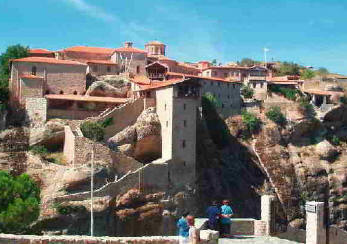
According to the
theory of the German geologist Al Philipson, the rocks of Meteora
were formed by the huge mass of river stones, sand and mud, which
were united to create a united cone.
When later, the waters
of the Thessalian lake ran into the Aegean sea, this united mass was
split because of the corrosive action of the water, the strong
winds, the heavy rains and the seismic vibrations, creating hills
and rocks in different shapes and sizes.
The solidification of
the river stones and the sand into compact rocks was the result of
the dissolution of the limestones, as well as because of the
pressure, which was forced for many thousand years on the lowest
fossils from the highest ones.
Philipson’ s aspect is
considered complete because it explains the pebbly character of the
rocks and the hills, and also these explanations are not opposed to
the tradition that refers to the sea of Thessaly.
In the prefecture of
Trikala and at a distance of 20 km from Trikala above Kalambaka,
rise proud and imposing the stony rocks of The Holy Meteora full of
petrified shells, revealing a unique geological phenomenon. At the
land of Meteora the height of the rocks reaches 400 meters. It is
the most significant monastery ground in Greece after the Holy
Mountain.
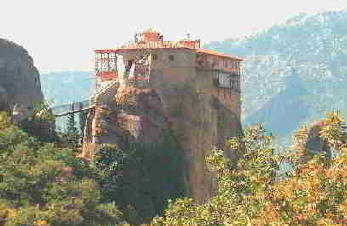
On these untdodden
peaks in about 1100 a.d., the first ascetics came to Meteora. They
climbed and nested like birds into the caves and in the cavities of
the rocks isolated, looking for the completion and salvation of
their soul, with prayers and fast. The rocks stand between the earth
and the sky. Those who had the patience to count them found that
they are over one thousand.
In the 14th
century St Athanasios of Meteora formed the first organized monastic
convent with rules, according to the typical of the organized
monasteries of the Holy Mountain. They were called Meteora, thanks
to St Athanasios of Meteora, from the Monastery of the Great Meteoro.
Since then Monks and Nuns have come and settled on the holy rocks
where they work hard day and night with fast, vigilance and try, not
only for their salvation but also for the salvation of all the
people, with hours of prayers and entreaties.
24 monasteries have
been founded from the year 1350 till 1500 a.c., but because of the
damage caused by the years passing by and the passing of the
centuries, most of the monasteries have remained unoccupied and few
ruins exist till today.
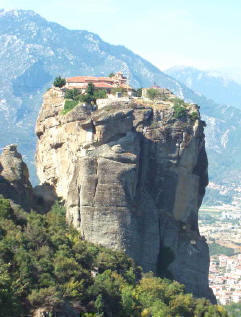
In the beginning of
the 18th century starts the decade of the ascetism of
Meteora and as a result the number of the monasteries and that of
the monks has been reduced enough and only few monks care for their
survival reformation.
Since 1960 till today
some works of renovation and restoration of the monuments have begun
with the expenses and the care of the monks of the monastic state of
the Holy Mountain. With the cooperation of the 7th Tax
Office of Byzantine Monuments, the renovation of the buildings of
the monasteries takes place. As well, monks and nuns with their
expenses and care maintain artistic hand writings, portable icons
and hagiographies, golden embroideries and wood curved objects, holy
valuable articles and consecrated vessels of inconsiderable art of
important historical and national value.
At the field of
communication and projection of the Holy Meteora, the monastic state
has to present a great and exact work. They have edited a great
number of books of scientific and aesthetic level in many languages,
artistic albums, biographies of Saints and tourist guides. On the
market are:
Ø
Documentaries of video tape “Holy Meteora: The catacombs of the
sky”, in many languages.
Ø
Tapes:
“Meteora: The Holy Place”, with Byzantine hymns, as well as cards,
posters, leaflets, etc.
Many of these editions
have been distributed free at the offices of Greek Organization of
Tourism, service and other organizations of Greece and abroad, in
order to enlighten the Greeks living abroad and the foreigners,
creating an important national work.
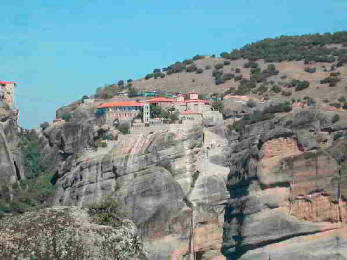
On the 29th
of September 1990 the Monastic state of Meteora had the exceptional
honor to accept the visit of the Ecumenical Patriarch Dimitrios.
The Holy Meteora have
been acknowledged as maintained and protected monument of humanity
by UNESCO and other national organizations. In 1995 they have been
announced as “Holy land unchangeable and inviolable”, which saves
their orthodox authentity and their effective protection.
Through the centuries
the monasteries of Meteora have to present rich action. They offered
a lot and still keep offering, not only to the Orthodox monarchism,
but also to the church and the Greek Nation, with their contribution
to the conservation of our cultural tradition and inheritance.
Monks and nuns who are
devoted to Christ and brought up to the “Thivaida of Stagon” carry
in their hearts the religious character, the cultural content of the
Holy Meteora and the spiritual and national role of our Monastic
state in the contemporary world.
The contribution of
the monasteries to the field of education has been significant. They
founded schools to save the Greek language and the Orthodox belief
as well. For these reasons in the middle of the 16th
century the Socration’s Academy of Meteora had been formed.
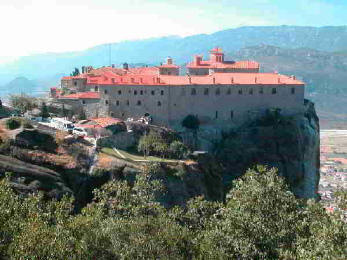
The scholar Bishop of
Stagon, Paision Klinovitis (1784-1808) donated in his will his rich
library to the Holy Monastery of Saint Stephanos. The school of
Saint Stephanos attended among the others the scholar hierarch and
big benefactor of our Nation, Dorotheos Scholarios (1812-1889).
Later he founded the Dorothean School in Trikala.
Their interest for
education was great. In 1845 the head monks of the Monasteries:
Varlaam, Meteora and St Stephanos subscribe the three of them a
letter and they take the responsibility to contribute 500 grosia to
the schools of Trikki for teacher’s payment.
The well known head
monk Konstantios of the Monastery of St Stephanos, in the middle of
19th century, founded the Konstantion school of Kalambaka.
He also gave a lot of money for the raising of schools in Trikala.
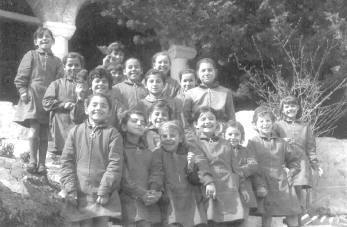
But mostly in the
Monasteries with their worshiping life, our orthodox belief has been
maintained and also the Greek language has remained pure, that
language which allowed the enslaved to understand the Psaltiri and
the Octaiho and also helped them to preserve their fighting
vigilance, their national consciousness
and their desire for obtaining their freedom.
The country side and
the Holy Monasteries cause you indeterminate emotions. The wild
surroundings, the warm approaching of the Monasteries and the tensed
emotional burdens overwhelm the human being and take him away from
his everyday routine. An ideal place for “The life according to
Christ”.
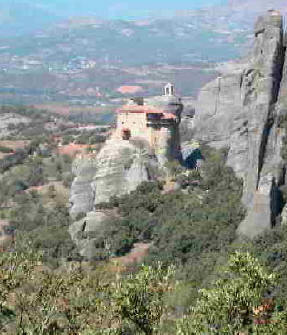
The functioning
monasteries are only 6 today:
-
The Monastery of Great
Meteoron or the Monastery of the Transfiguration
-
The Monastery of Varlaam or All
Saints
-
The Monastery of St Stephanos
-
The Monastery of St Nikolas
Anapafsas
-
The Monastery of St
Barbara/Rousanou
-
The Monastery of The Holy
Trinity
Μετάφραση:Δήμητρα
Κοκώνη

|

H
ανάβαση στα μοναστήρια με τη σκάλα και το δίχτυ |
 |
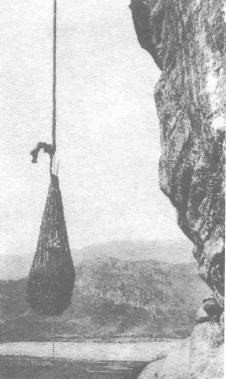 |
